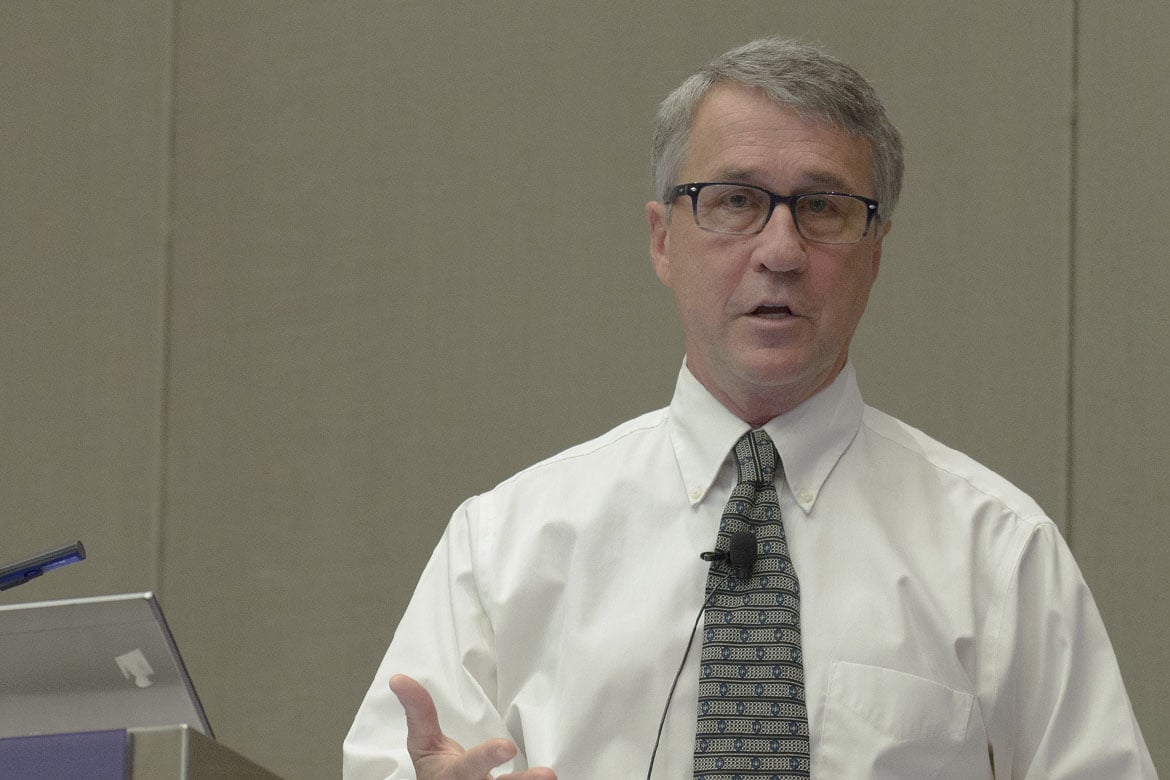Physicians often ignore stress because there’s a lack of immediate action. This places further importance on the need to engage in effective coping mechanisms by creating a culture of wellness for physicians. When stress is reduced, physicians are happier and collaborate more with other physicians.
Thomas Cox, PsyD, director of education, faculty and research development at Baylor Scott & White Health System North, and the Dallas campus.
During two recent education sessions at the 2017 AMA Annual Meeting in Chicago, Thomas Cox, PsyD, and Philip Cass, PhD, emphasized the importance of stress management and practicing mindfulness meditation to help combat physician burnout. Cox is director of education, faculty and research development at Baylor Scott & White Health System North, and the Dallas campus. Cass is the immediate past CEO of the Columbus (Ohio) Medical Association and affiliated organizations.
Stress is viewed as harmful, whether its source is emotional or professional. For physicians, though, practicing medicine can often produce chronic stress. Without proper management, physicians can feel the effects of burnout even early on in their careers.
Don’t avoid stress; manage it
A physician’s daily schedule is extremely challenging, with “75 percent of physicians experiencing extreme stress at least one time a day on average and feeling stressed 35 percent of the time,” Cox explained. However, physicians who kept a daily record of stressful events throughout their day found they experienced less stress almost half of the time.
Working in highly stressful environments, many physicians seek perfection, which is a precursor for burnout. When this stress remains in the future, physicians can’t solve the problem. Instead, the threat is in their mind rather than immediately present.
This creates chronic stress because there isn’t a way to take immediate action. Instead, Cox suggests managing stress by:
- Sleeping.
- Eating balanced meals.
- Participating in physical activity.
- Socializing.
- Taking vacations or having down times.
- Engaging in spiritual activities.
- Having a primary care physician to talk to.
Burnout often begins in medical school, with many physicians meeting the criteria long before they even begin treating patients because they don’t learn stress management. Instead, medical students find other ways to avoid stress, such as drinking and binge sleeping.
“What I’ve noticed about physicians is that they’re all masters of disguise because of the necessity to hide their emotions,” Cox said. “They’re also called to cope and adapt with the stress of characteristics of the job and to not transfer their emotions onto their patients or their family.”
If a physician is suffering from burnout, the consequences can be detrimental to patient care, including misdiagnosis, hostility toward patients and medical errors. Dissatisfied physicians are even more likely to reduce clinical work hours, leave their practice and retire early.
To combat burnout, Cox recommended creating “a culture of wellness for physicians” by:
- Educating about burnout.
- Implementing stress-reduction programs.
- Encouraging a team-based approach to patient care.
- Ensuring a reasonable and equitable workload.
- Encouraging individuality among faculty.
- Committing to faculty and staff wellness training.
- Allowing autonomy and schedule flexibility to encourage work-family balance.
- Advocating for transparency and fairness with regard to faculty.
He also reiterated that physicians are valuable and that “self-care is the foundation to faculty vitality and remaining professional.”
A daily ritual
Expanding on physician burnout and stress, Cass offered a solution: practicing mindfulness. One of the hottest things occurring in today’s business and medical practices is mindfulness, which is a practice that is 2,500 years old, Cass said.
To introduce the practice of mindfulness, he instructed physicians to place their hands on their thighs and rest. Physicians were then instructed to pay attention to their breathing by counting 10 breaths. If a thought crossed their minds, Cass told physicians to simply go back to counting.
With a room full of physicians at rest, he explained that performing this routine daily, or even several times a day, can help change physicians’ daily life and feelings. This is mindfulness, Cass said. Whether physicians choose to perform this routine when logging into their computer or before exiting the car, mindfulness can help with relaxation, as well as finding calmness before beginning their day.
“Mindfulness is a way of being attentive to the moment to moment,” Cass explained. “The key to this definition is a non-judgmental state about yourself and other people.”
Cass said the practice of mindfulness meditation offers the following benefits for physicians:
- Reduces stress.
- Regulates pain.
- Boosts working memory.
- Improves focus.
- Lowers emotional reactivity.
- Increases cognitive flexibility.
- Boosts relationship satisfaction.
At the first onset of burnout, physicians should listen to their patients rather than forcing a solution. Cass urged physicians to participate in mindfulness meditation because it can remind them “what it feels like to be in the moment” and that they have inherent dignity as human beings, not just as physicians.
Read more news coverage of the 2017 AMA Annual Meeting.




